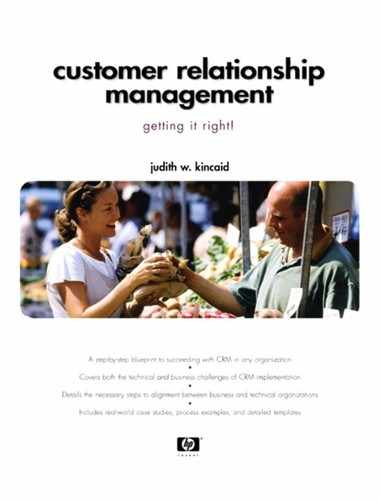Chapter 17. Finding the “Right” Customers
We've defined our strategy and built a piece of our CRM infrastructure; now we're ready to turn our focus outside and identify the specific characteristics and customers who are most likely to respond to the offer we plan to make. We use information about our customers to make predictions about how they will respond to our offers. We also use information to measure the results of our efforts (see Chapter 19). Information is the raw material of CRM.
For now, we will focus on using information to identify the right customers to receive our offer. To be effective, an offer must generate a response. To get a response, understand what our customers are like, what they value and how they are likely to behave (respond). Like most of the other life cycle phases, we started thinking about key customers early in the methodology at a high-level perspective. (Actually I hope we all have been thinking about our customers even before CRM.) But now it's time to work our way through to finding the specific customers who will be targeted for the current project. First, we will get to know our customers well enough that we can identify groups or segments likely to respond to the same offer the same way. Then we'll pick (target) exactly which customers to include.
Segmentation and targeting are iterative. Every company is likely to pick some high-level strategic segments very early, even before a CRM program is launched. Often, these segments are based on broad customer characteristics, such as whether this is a consumer or business customer, or large versus small businesses. Intuitively and experientially, we believe these groups are different. (By the way, one benefit of CRM is that we can use information we've gathered to validate and refine these early assumptions.)
Next, for each project, we identify a target profile (set of characteristics) during the project launch. These are the customers to whom we plan to send the offer because we believe they will return the most value. Next, we are likely to segment our customer information according to the characteristics of the target profile. Then we refine our early criteria and target the specific set of customers to whom we'll actually deliver the offer. Again, we may segment this targeted group into smaller groups who are likely to behave differently based on other characteristics. Of course, we're all aware of the dangers of analysis paralysis by this time, so we'll definitely apply common sense about the number of repetitions.
During the strategic planning efforts discussed in Chapter 8, XYZ identified its strategic customer segments. (Remember they asked about customer segmentation during the internal interviews.) Strategic segmentation takes a very gross cut at profile similarities and differences among customer groups and is used to help your company make global decisions as to how the company organizes or sets strategy. As the business changes, strategies may change and so can strategic segments. We will also build segments that are much more precise and detailed. These “project” segments are identified as we identify the specific audience for a particular project offer. XYZ's strategic segments are shown in Figure 17-1.
Figure 17-1. XYZ's strategic segments

XYZ's first segmentation cut was to separate consumers from business contacts as having quite different needs and potential value. Then it chose to create two business segments: the top-valued customers and the rest. They found no strategically different groups within the consumer segment.
There are many tools that help us use information to make the best possible decisions about which customers we want to include in the current offer. CRM in theory is about relating to customers personally and individually. But in practice, most of us have to find groups of customers who are enough alike that we can relate to all members in about the same way. We apply the various decision support tools to the information we have collected to help us understand our customers and recognize similar groups. Then we can use the same or similar methods to pick the segments that we believe are the most likely to respond. We're starting the third phase of our CRM life cycle and will cover both Phase 3 and the transition to Phase 4, as shown in Figure 17-2.
Figure 17-2. Phase 3: Know your customers

Get to know your customers! That doesn't mean you should have each one over for dinner. This life cycle phase is about creating customer segments or groups that respond about the same way. Segments, according to Webster's, are sections defined by “natural” boundaries. An orange can easily be separated into pieces because it has naturally defined segments. Customer segments also have natural boundaries that are defined by having similar sets of characteristics, which we call profiles. We want members of the segment to react the same way as long as we treat them all about the same. And we want to treat them differently from how we treat all the other customer segments.
Before we get started putting customers into similar groups, we need to understand the different types of characteristics that make up a customer's profile and where the data comes from. We'll look at the three different sources of customer profile data: marketplace facts that describe customers as they exist in the world, relationship facts that describe your company's interactions with customers, and calculated facts that come from finding patterns and relationships between the other two types.
